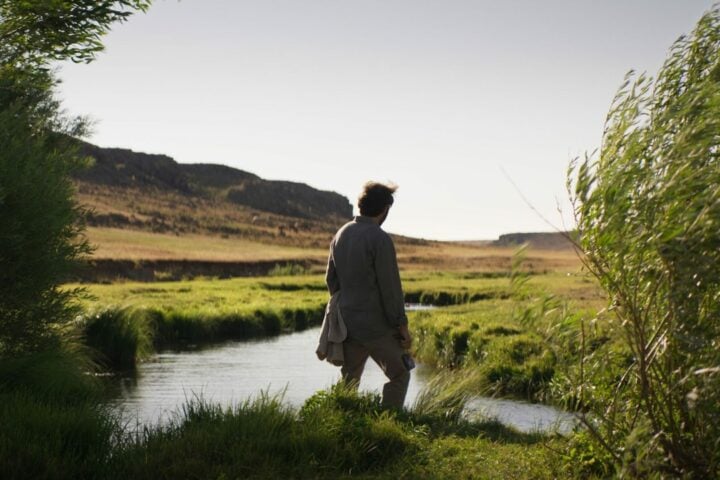At the heart of Pham Tien An’s sprawling feature debut, Inside the Yellow Cocoon Shell, is a protagonist so unmoored from his surroundings that he looks forever on the cusp of floating away at the slightest breeze. Thien (Le Phong Vu) first appears sitting in an outdoor café in Saigon with a few friends, a local pickup game of soccer playing out to his right and the patrons behind him cheering on a televised professional match in between bites of food. Ignoring the hubbub around him, Thien asks his friends about matters of faith but looks uninterested in his own topic, zoning out as others talk about their religious beliefs.
Thien is so alienated from his environment that when a motorcycle crashes next to the café, he’s one of the few people in the vicinity who doesn’t react, remaining seated as others head over to survey the damage. The young man is shocked out of his ennui, though, by the revelation that one of the victims of that crash was his sister-in-law, Hanh. With Thien’s brother, Tam, having long ago abandoned his wife, it falls to Thien to escort Hanh’s body back to their rural hometown, as well as to provide care for his five-year-old nephew, Dao (Nguyen Thinh).
Compared to his numbed reaction to the present, Thien finds motivation in retracing the past he left behind when he moved to the city, and Inside the Yellow Cocoon Shell patiently observes him rekindling prior relationships, whether checking in with village elders or running into an ex-girlfriend, Thao (Nguyen Thi Truc Quynh), who’s since become a nun. One gradually gets the sense that, though the man left his home to get away from a feeling of being suffocated, he feels far more at ease in the realm of nostalgia than he does in the uncertainty of the present moment.
Pham follows Thien with a series of long takes that match their technical dazzle with textural resonance. By letting each scene play out in near-real time, Pham emphasizes Thien’s slow process of reconnecting with his roots, as well as the contrast between the pace of life that characterizes the village, where the slow camera movements and shot durations feel natural, and Saigon, where they come across as unnaturally sedentary. Though the film does employ one flashback that juxtaposes Thien’s awkward reunion with a now-chaste Thao with their amorous affair as young adults, for the most part the past is conjured in real time as the weight of unresolved relationships and things left unsaid plays out between Thien and others.
Pham made several shorts prior to this feature, including the ambitious one-take Stay Awake, Be Ready, but it’s still remarkable to witness the confidence with which this young, relatively untested filmmaker frames a shot and communicates so much through on- and off-screen space. Pham captures Thien’s transportation of Hanh’s body out of Saigon with a shot gazing out the back of a car, her casket at the bottom of the frame, setting the somber reminder of her death against the quotidian bustle of the city streets seen out the rear window. Scenes that begin in long shot find the camera moving closer to the actors as Thien becomes more engrossed in conversation, reflecting how his aloofness crumbles in the face of even a fleeting connection.
In the film’s most arresting moment, the man pays a respectful visit to an elderly man who helped to look after Hanh after Tam ran away, and what begins as a distanced shot of Thien being deferential around the man grows more intimate as the old-timer starts to reminisce about his days as an ARVN soldier. Eventually, the veteran leads Thien from the front room of his home to a darkened chamber filled with photographs and medals. The faint amber glow of the lightbulb illuminating the room gives the film’s images a subtle sepia tint, deepening the sense that Thien is traveling into the past even as he remains in the present.
Thien’s interaction with that man is one of several moments scattered across Inside the Yellow Cocoon Shell where he converses with an elderly person who advises him on how to overcome his feelings of restlessness. During their exchange, the veteran admits that he spent many years feeling as if he was good only for combat and learned to belatedly reintegrate into normal life by helping others. And late in the film, an old woman notes that the kind of human suffering that’s led Thien to his crisis of faith has always existed and that it’s the manner in which we find pathways out of our misery that demonstrate grace, be it divine or self-actualized.
Thien may feel cut off from the world, but Inside the Yellow Cocoon Shell is deeply in harmony with it, from its masterful sound design that fills in off-screen space with ambient noises, to its observant long takes, to the deference it shows to the wisdom and experience that elders can impart on the young. Even when Thien heads off on a likely futile search for his long-lost brother, the mere fact of his seeking reveals a growth that the man may not realize in himself—an active commitment to repair relationships that he once passively discarded.
Since 2001, we've brought you uncompromising, candid takes on the world of film, music, television, video games, theater, and more. Independently owned and operated publications like Slant have been hit hard in recent years, but we’re committed to keeping our content free and accessible—meaning no paywalls or fees.
If you like what we do, please consider subscribing to our Patreon or making a donation.



